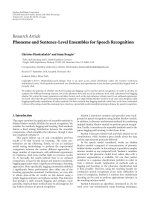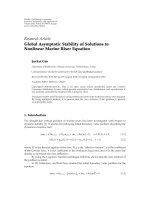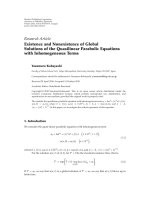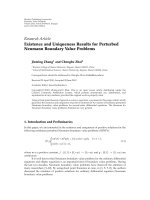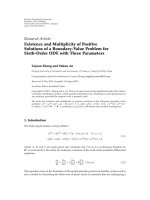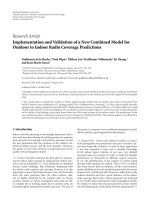Báo cáo hóa học: "Research Article Existence and Uniqueness of Solutions for Higher-Order Three-Point Boundary Value Problems" ppt
Bạn đang xem bản rút gọn của tài liệu. Xem và tải ngay bản đầy đủ của tài liệu tại đây (523.36 KB, 16 trang )
Hindawi Publishing Corporation
Boundary Value Problems
Volume 2009, Article ID 362983, 16 pages
doi:10.1155/2009/362983
Research Article
Existence and Uniqueness of
Solutions for Higher-Order Three-Point
Boundary Value Problems
Minghe Pei
1
and Sung Kag Chang
2
1
Department of Mathematics, Bei Hua University, JiLin 132013, China
2
Department of Mathematics, Yeungnam University, Kyongsan 712-749, South Korea
Correspondence should be addressed to Sung Kag Chang,
Received 5 February 2009; Accepted 14 July 2009
Recommended by Kanishka Perera
We are concerned with the higher-order nonlinear three-point boundary value problems: x
n
ft, x, x
, ,x
n−1
,n ≥ 3, with the three point boundary conditions gxa,x
a, ,x
n−1
a
0; x
i
bμ
i
,i 0, 1, ,n− 3; hxc,x
c, ,x
n−1
c 0, where a<b<c,f: a, c × R
n
→
R −∞, ∞ is continuous, g, h : R
n
→ R are continuous, andμ
i
∈ R,i 0, 1, ,n − 3are
arbitrary given constants. The existence and uniqueness results are obtained by using the method
of upper and lower solutions together with Leray-Schauder degree theory. We give two examples
to demonstrate our result.
Copyright q 2009 M. Pei and S. K. Chang. This is an open access article distributed under the
Creative Commons Attribution License, which permits unrestricted use, distribution, and
reproduction in any medium, provided the original work is properly cited.
1. Introduction
Higher-order boundary value problems were discussed in many papers in recent years; for
instance, see 1–22 and references therein. However, most of all the boundary conditions in
the above-mentioned references are for two-point boundary conditions 2–11, 14, 17–22,and
three-point boundary conditions are rarely seen 1, 12, 13, 16, 18. Furthermore works for
nonlinear three point boundary conditions are quite rare in literatures.
The purpose of this article is to study the existence and uniqueness of solutions for
higher order nonlinear three point boundary value problem
x
n
f
t, x, x
, ,x
n−1
,n≥ 3, 1.1
2 Boundary Value Problems
with nonlinear three point boundary conditions
g
x
a
,x
a
, ,x
n−1
a
0,
x
i
b
μ
i
,i 0, 1, ,n− 3,
h
x
c
,x
c
, ,x
n−1
c
0,
1.2
where a<b<c, f : a, c × R
n
→ R −∞, ∞ is a continuous function, g,h : R
n
→ R are
continuous functions, and μ
i
∈ R,i 0, 1, ,n− 3 are arbitrary given constants. The tools we
mainly used are the method of upper and lower solutions and Leray-Schauder degree theory.
Note that for t he cases of a b or b c in the boundary conditions 1.2, our theorems
hold also true. However, for brevity we exclude such cases in this paper.
2. Preliminary
In this section, we present some definitions and lemmas that are needed to our main results.
Definition 2.1. αt,βt ∈ C
n
a, c are called lower and upper solutions of BVP 1.1, 1.2,
respectively, if
α
n
t
≥ f
t, α
t
,α
t
, ,α
n−1
t
,t∈
a, c
,
g
α
a
,α
a
, ,α
n−1
a
≤ 0,
α
i
b
≤ μ
i
,i 0, 1, ,n− 3,
h
α
c
,α
c
, ,α
n−1
c
≤ 0,
β
n
t
≤ f
t, β
t
,β
t
, ,β
n−1
t
,t∈
a, c
,
g
β
a
,β
a
, ,β
n−1
a
≥ 0,
β
i
b
≥ μ
i
,i 0, 1, ,n− 3,
h
β
c
,β
c
, ,β
n−1
c
≥ 0.
2.1
Definition 2.2. Let E be a subset of a, c × R
n
. We say that ft, x
0
,x
1
, ,x
n−1
satisfies the
Nagumo condition on E if there exists a continuous function φ : 0, ∞ → 0, ∞ such that
f
t, x
0
,x
1
, ,x
n−1
≤ φ
|
x
n−1
|
,
t, x
0
,x
1
, ,x
n−1
∈ E,
∞
0
sds
φ
s
∞.
2.2
Lemma 2.3 see 10. Let f : a, c × R
n
→ R be a continuous function satisfying the Nagumo
condition on
E
t, x
0
,x
1
, ,x
n−1
∈
a, c
× R
n
: γ
i
t
≤ x
i
≤ Γ
i
t
,i 0, 1, ,n− 2
, 2.3
Boundary Value Problems 3
where γ
i
t, Γ
i
t : a, c → R are continuous functions such that
γ
i
t
≤ Γ
i
t
,i 0, 1, ,n− 2,t∈
a, c
. 2.4
Then there exists a constant r>0 (depending only on γ
n−2
t, Γ
n−2
t and φt such that every
solution xt of 1.1 with
γ
i
t
≤ x
i
t
≤ Γ
i
t
,i 0, 1, ,n− 2,t∈
a, c
2.5
satisfies x
n−1
∞
≤ r.
Lemma 2.4. Let φ : 0, ∞ → 0, ∞ be a continuous function. Then boundary value problem
x
n
x
n−2
φ
x
n−1
,t∈
a, c
, 2.6
x
n−2
a
x
i
b
x
n−2
c
0,i 0, 1, ,n− 3
2.7
has only the trivial solution.
Proof. Suppose that x
0
t is a nontrivial solution of BVP 2.6, 2.7. Then there exists t
0
∈
a, c such that x
n−2
0
t
0
> 0orx
n−2
0
t
0
< 0. We may assume x
n−2
0
t
0
> 0. There exists
t
1
∈ a, c such that
max
t∈
a,c
x
n−2
0
t
: x
n−2
0
t
1
> 0.
2.8
Then x
n−1
0
t
1
0, x
n
0
t
1
≤ 0. From 2.6 we have
0 ≥ x
n
0
t
1
x
n−2
0
t
1
φ
x
n−1
0
t
1
> 0, 2.9
which is a contradiction. Hence BVP 2.6, 2.7 has only the trivial solution.
3. Main Results
We may now formulate and prove our main results on the existence and uniqueness of
solutions for nth-order three point boundary value problem 1.1, 1.2.
Theorem 3.1. Assume that
i there exist lower and upper solutions αt,βt of BVP 1.1, 1.2, respectively, such that
−1
n−i
α
i
t
≤
−1
n−i
β
i
t
,t∈
a, b
,i 0, 1, ,n− 2,
α
i
t
≤ β
i
t
,t∈
b, c
,i 0, 1, ,n− 2;
3.1
4 Boundary Value Problems
ii ft, x
0
, ,x
n−1
is continuous on a, c×R
n
, −1
n−i
ft, x
0
, ,x
n−1
is nonincreasing in
x
i
i 0, 1, ,n− 3 on D
b
a
, and ft, x
0
, ,x
n−1
is nonincreasing in x
i
i 0, 1, ,n−
3 on D
c
b
and satisfies the Nagumo condition on D
c
a
,where
ϕ
i
t
min
α
i
t
,β
i
t
,ψ
i
t
max
α
i
t
,β
i
t
,i 0, ,n− 2,
D
b
a
t, x
0
, ,x
n−1
∈
a, b
× R
n
: ϕ
i
t
≤ x
i
≤ ψ
i
t
,i 0, ,n− 2
,
D
c
b
t, x
0
, ,x
n−1
∈
b, c
× R
n
: ϕ
i
t
≤ x
i
≤ ψ
i
t
,i 0, ,n− 2
,
D
c
a
t, x
0
, ,x
n−1
∈
a, c
× R
n
: ϕ
i
t
≤ x
i
≤ ψ
i
t
,i 0, ,n− 2
;
3.2
iii gx
0
,x
1
, ,x
n−1
is continuous on R
n
, and −1
n−i
gx
0
,x
1
, ,x
n−1
is nonincreasing
in x
i
i 0, 1, ,n− 3 and nondecreasing in x
n−1
on
n−2
i0
ϕ
i
a,ψ
i
a × R;
iv hx
0
,x
1
, ,x
n−1
is continuous on R
n
, and nonincreasing in x
i
i 0, 1, ,n− 3 and
nondecreasing in x
n−1
on
n−2
i0
ϕ
i
c,ψ
i
c × R.
Then BVP 1.1, 1.2 has at least one solution xt ∈ C
n
a, c such that for each i 0, 1, ,n− 2,
−1
n−i
α
i
t
≤
−1
n−i
x
i
t
≤
−1
n−i
β
i
t
,t∈
a, b
,
α
i
t
≤ x
i
t
≤ β
i
t
,t∈
b, c
.
3.3
Proof. For each i 0, 1, ,n− 2 define
w
i
t, x
⎧
⎪
⎪
⎪
⎨
⎪
⎪
⎪
⎩
ψ
i
t
,x>ψ
i
t
,
x, ϕ
i
t
≤ x ≤ ψ
i
t
,
ϕ
i
t
,x<ϕ
i
t
,
3.4
where ϕ
i
tmin{α
i
t,β
i
t}, ψ
i
tmax{α
i
t,β
i
t}.
For λ ∈ 0, 1, we consider the auxiliary equation
x
n
t
λf
t, w
0
t, x
t
, ,w
n−2
t, x
n−2
t
,x
n−1
t
x
n−2
t
− λw
n−2
t, x
n−2
t
φ
x
n−1
t
,
3.5
where φ is given by the Nagumo condition, with the boundary conditions
x
n−2
a
λ
w
n−2
a, x
n−2
a
− g
w
0
a, x
a
, ,w
n−2
a, x
n−2
a
,x
n−1
a
,
x
i
b
λμ
i
,i 0, 1, ,n− 3,
x
n−2
c
λ
w
n−2
c, x
n−2
c
− h
w
0
c, x
c
, ,w
n−2
c, x
n−2
c
,x
n−1
c
.
3.6
Boundary Value Problems 5
Then we can choose a constant M
n−2
> 0 such that
−M
n−2
<α
n−2
t
≤ β
n−2
t
<M
n−2
,t∈
a, c
, 3.7
f
t, α
t
, ,α
n−2
t
, 0
−
M
n−2
α
n−2
t
φ
0
< 0,t∈
a, c
,
f
t, β
t
, ,β
n−2
t
, 0
M
n−2
− β
n−2
t
φ
0
> 0,t∈
a, c
,
3.8
α
n−2
a
− g
α
a
, ,α
n−2
a
, 0
<M
n−2
,
β
n−2
a
− g
β
a
, ,β
n−2
a
, 0
<M
n−2
,
3.9
α
n−2
c
− h
α
c
, ,α
n−2
c
, 0
<M
n−2
,
β
n−2
c
− h
β
c
, ,β
n−2
c
, 0
<M
n−2
.
3.10
In the following, we will complete the proof in four steps.
Step 1. Show that every solution xt of BVP 3.5, 3.6 satisfies
x
n−2
t
<M
n−2
,t∈
a, c
, 3.11
independently of λ ∈ 0, 1.
Suppose that the estimate |x
n−2
t| <M
n−2
is not true. Then there exists t
0
∈ a, c
such that x
n−2
t
0
≥ M
n−2
or x
n−2
t
0
≤−M
n−2
. We may assume x
n−2
t
0
≥ M
n−2
. There
exists t
1
∈ a, c such that
max
t∈
a,c
x
n−2
t
: x
n−2
t
1
≥ M
n−2
> 0
.
3.12
There are three cases to consider.
Case 1 t
1
∈ a, c. In this case, x
n−1
t
1
0andx
n
t
1
≤ 0. For λ ∈ 0, 1,by3.8,weget
the following contradiction:
0 ≥ x
n
t
1
λf
t
1
,w
0
t
1
,x
t
1
, ,w
n−2
t
1
,x
n−2
t
1
,x
n−1
t
1
x
n−2
t
1
− λw
n−2
t
1
,x
n−2
t
1
φ
x
n−1
t
1
λf
t
1
,w
0
t
1
,x
t
1
, ,w
n−3
t
1
,x
n−3
t
1
,β
n−2
t
1
, 0
x
n−2
t
1
− λβ
n−2
t
1
φ
0
≥ λ
f
t
1
,β
t
1
, ,β
n−2
t
1
, 0
M
n−2
− β
n−2
t
1
φ
0
> 0,
3.13
6 Boundary Value Problems
and for λ 0, we have the following contradiction:
0 ≥ x
n
t
1
x
n−2
t
1
φ
0
≥ M
n−2
φ
0
> 0.
3.14
Case 2 t
1
a. In this case,
max
t∈
a,c
x
n−2
t
: x
n−2
a
≥ M
n−2
> 0
,
3.15
and x
n−1
a ≤ 0. For λ 0, by 3.6 we have the following contradiction:
0 <M
n−2
≤ x
n−2
a
0.
3.16
For λ ∈ 0, 1,by3.9 and condition iii we can get the following contradiction:
M
n−2
≤ x
n−2
a
,
λ
w
n−2
a, x
n−2
a
− g
w
0
a, x
a
, ,w
n−2
a, x
n−2
a
,x
n−1
a
,
≤ λ
β
n−2
a
− g
β
a
, ,β
n−2
a
, 0
<M
n−2
.
3.17
Case 3 t
1
c. In this case,
max
t∈
a,c
x
n−2
t
: x
n−2
c
≥ M
n−2
> 0
,
3.18
and x
n−1
c ≥ 0. For λ 0, by 3.6 we have the following contradiction:
0 <M
n−2
≤ x
n−2
c
0.
3.19
For λ ∈ 0, 1,by3.10 and condition iv we can get the following contradiction:
M
n−2
≤ x
n−2
c
,
λ
w
n−2
c, x
n−2
c
− h
w
0
c, x
c
, ,w
n−2
c, x
n−2
c
,x
n−1
c
≤ λ
β
n−2
c
− h
β
c
, ,β
n−2
c
, 0
<M
n−2
.
3.20
By 3.6, the estimates
x
i
t
<M
i
:
c − a
M
i1
μ
i
,i 0, 1, ,n− 3,t∈
a, c
3.21
are obtained by integration.
Boundary Value Problems 7
Step 2. Show that there exists M
n−1
> 0 such that every solution xt of BVP 3.5, 3.6
satisfies
x
n−1
t
<M
n−1
,t∈
a, c
, 3.22
independently of λ ∈ 0, 1.
Let
E
{
t, x
0
, ,x
n−1
∈
a, c
× R
n
:
|
x
i
|
≤ M
i
,i 0, 1, ,n− 2
}
, 3.23
and define the function F
λ
: a, c × R
n
→ R as follows:
F
λ
t, x
0
, ,x
n−1
λf
t, w
0
t, x
0
, ,w
n−2
t, x
n−2
,x
n−1
x
n−2
− λw
n−2
t, x
n−2
φ
|
x
n−1
|
.
3.24
In the following, we show that F
λ
t, x
0
, ,x
n−1
satisfies the Nagumo condition on E,
independently of λ ∈ 0, 1. In fact, since f satisfies the Nagumo condition on D
c
a
, we have
|
F
λ
t, x
0
, ,x
n−1
|
λf
t, w
0
t, x
0
, ,w
n−2
t, x
n−2
,x
n−1
x
n−2
− λw
n−2
t, x
n−2
φ
|
x
n−1
|
≤
1 2M
n−2
φ
|
x
n−1
|
: φ
E
|
x
n−1
|
.
3.25
Furthermore, we obtain
∞
0
s
φ
E
s
ds
∞
0
s
1 2M
n−2
φ
s
ds ∞.
3.26
Thus, F
λ
satisfies the Nagumo condition on E, independently of λ ∈ 0, 1.Let
γ
i
t
−M
i
, Γ
i
t
M
i
,i 0, 1, ,n− 2,t∈
a, c
. 3.27
By Step 1 and Lemma 2.3, there exists M
n−1
> 0 such that |x
n−1
t| <M
n−1
for t ∈ a, c. Since
M
n−2
and φ
E
do not depend on λ, the estimate |x
n−1
t| <M
n−1
on a, c is also independent
of λ.
Step 3. Show that for λ 1, BVP 3.5, 3.6 has at least one solution x
1
t.
Define the operators as follows:
L : C
n
a, c
⊂ C
n−1
a, c
−→ C
a, c
× R
n
, 3.28
8 Boundary Value Problems
by
Lx
x
n
t
,x
n−2
a
,x
b
, ,x
n−3
b
,x
n−2
c
,
N
λ
: C
n−1
a, c
−→ C
a, c
× R
n
,
3.29
by
N
λ
x
F
λ
t, x
t
, ,x
n−1
t
,A
λ
,λμ
0
, ,λμ
n−3
,C
λ
, 3.30
with
A
λ
: λ
w
n−2
a, x
n−2
a
− g
w
0
a, x
a
, ,w
n−2
a, x
n−2
a
,x
n−1
a
C
λ
: λ
w
n−2
c, x
n−2
c
− h
w
0
c, x
c
, ,w
n−2
c, x
n−2
c
,x
n−1
c
.
3.31
Since L
−1
is compact, we have the following compact operator:
T
λ
: C
n−1
a, c
−→ C
n−1
a, c
,
3.32
defined by
T
λ
x
L
−1
N
λ
x
.
3.33
Consider the set Ω{x ∈ C
n−1
a, c : x
i
∞
<M
i
,i 0, 1, ,n− 1}.
By Steps 1 and 2, the degree degI − T
λ
, Ω, 0 is well defined for every λ ∈ 0, 1, and
by homotopy invariance, we get
deg
I − T
0
, Ω, 0
deg
I − T
1
, Ω, 0
. 3.34
Since the equation x T
0
x has only the trivial solution from Lemma 2.4, by the degree
theory we have
deg
I − T
1
, Ω, 0
deg
I − T
0
, Ω, 0
±1. 3.35
Hence, the equation x T
1
x has at least one solution. That is, the boundary value problem
x
n
t
f
t, w
0
t, x
t
, ,w
n−2
t, x
n−2
t
,x
n−1
t
x
n−2
t
− w
n−2
t, x
n−2
t
φ
x
n−1
t
,
3.36
Boundary Value Problems 9
with the boundary conditions
x
n−2
a
w
n−2
a, x
n−2
a
− g
w
0
a, x
a
, ,w
n−2
a, x
n−2
a
,x
n−1
a
,
x
i
b
μ
i
,i 0, 1, ,n− 3,
x
n−2
c
w
n−2
c, x
n−2
c
− h
w
0
c, x
c
, ,w
n−2
c, x
n−2
c
,x
n−1
c
,
3.37
has at least one solution x
1
t in Ω.
Step 4. Show that x
1
t is a solution of BVP 1.1, 1.2.
In fact, the solution x
1
t of BVP 3.36, 3.37 will be a solution of BVP 1.1, 1.2,ifit
satisfies
ϕ
i
t
≤ x
i
1
t
≤ ψ
i
t
,i 0, 1, ,n− 2,t∈
a, c
.
3.38
By contradiction, suppose that there exists t
0
∈ a, c such that x
n−2
1
t
0
>ψ
n−2
t
0
. There
exists t
1
∈ a, c such that
max
t∈
a,c
x
n−2
1
t
− ψ
n−2
t
: x
n−2
1
t
1
− ψ
n−2
t
1
> 0.
3.39
Now there are three cases to consider.
Case 1 t
1
∈ a, c. In this case, since ψ
n−2
tβ
n−2
t on a, c, we have x
n−1
1
t
1
β
n−1
t
1
and x
n
1
t
1
≤ β
n
t
1
. By conditions i and ii, we get the following contradiction:
0 ≥ x
n
1
t
1
− β
n
t
1
≥ f
t
1
,w
0
t
1
,x
1
t
1
, ,w
n−2
t
1
,x
n−2
1
t
1
,x
n−1
1
t
1
x
n−2
1
t
1
− w
n−2
t
1
,x
n−2
1
t
1
φ
x
n−1
1
t
1
− f
t
1
,β
t
1
, ,β
n−1
t
1
≥ f
t
1
,β
t
1
, ,β
n−1
t
1
x
n−2
1
t
1
− β
n−2
t
1
φ
x
n−1
1
t
1
− f
t
1
,β
t
1
, ··· ,β
n−1
t
1
x
n−2
1
t
1
− β
n−2
t
1
φ
x
n−1
1
t
1
> 0.
3.40
Case 2 t
1
a. In this case, we have
max
t∈
a,c
x
n−2
1
t
− ψ
n−2
t
: x
n−2
1
a
− β
n−2
a
> 0,
3.41
10 Boundary Value Problems
and x
n−1
1
a ≤ β
n−1
a.By3.37 and conditions i and iii we can get the following
contradiction:
β
n−2
a
<x
n−2
1
a
,
w
n−2
a, x
n−2
1
a
− g
w
0
a, x
1
a
, ,w
n−2
a, x
n−2
1
a
,x
n−1
1
a
≤ β
n−2
a
− g
β
a
, ,β
n−2
a
,β
n−1
a
≤ β
n−2
a
.
3.42
Case 3 t
1
c. In this case, we have
max
t∈
a,c
x
n−2
1
t
− ψ
n−2
t
: x
n−2
1
c
− β
n−2
c
> 0,
3.43
and x
n−1
1
c ≥ β
n−1
c.By3.37 and conditions i and iv we can get the following
contradiction:
β
n−2
c
<x
n−2
1
c
w
n−2
c, x
n−2
1
c
− h
w
0
c, x
1
c
, ,w
n−2
c, x
n−2
1
c
,x
n−1
1
c
≤ β
n−2
c
− h
β
c
, ,β
n−2
c
,β
n−1
c
≤ β
n−2
c
.
3.44
Similarly, we can show that ϕ
n−2
t ≤ x
n−2
1
t on a, c. Hence
α
n−2
t
ϕ
n−2
t
≤ x
n−2
1
t
≤ ψ
n−2
t
β
n−2
t
,t∈
a, c
.
3.45
Also, by boundary condition 3.37 and condition i, we have
α
i
b
x
i
1
b
β
i
b
,i n − 1 − 2j, j 1, 2, ,
n − 1
2
,
α
i
b
≤ x
i
1
b
≤ β
i
b
,i n − 2 − 2j, j 1, 2, ,
n − 2
2
.
3.46
Therefore by integration we have for each i 0, 1, ,n− 2,
−1
n−i
α
i
t
≤
−1
n−i
x
i
1
t
≤
−1
n−i
β
i
t
,t∈
a, b
,
α
i
t
≤ x
i
1
t
≤ β
i
t
,t∈
b, c
,
3.47
Boundary Value Problems 11
that is,
ϕ
i
t
≤ x
i
1
t
≤ ψ
i
t
,i 0, 1, ,n− 2,t∈
a, c
.
3.48
Hence x
1
t is a solution of BVP 1.1, 1.2 and satisfies 3.3.
Now we give a uniqueness theorem by assuming additionally the differentiability for
functions f, g and h, and a kind of estimating condition in Theorem 3.1.
Theorem 3.2. Assume that
i there exist lower and upper solutions αt,βt of BVP 1.1, 1.2, respectively, such that
−1
n−i
α
i
t
≤
−1
n−i
β
i
t
,t∈
a, b
,i 0, 1, ,n− 2,
α
i
t
≤ β
i
t
,t∈
b, c
,i 0, 1, ,n− 2;
3.49
ii ft, x
0
, ,x
n−1
and its first-order partial derivatives in x
i
i 0, 1, ,n − 1 are
continuous on a, c × R
n
, −1
n−i
∂f/∂x
i
≤ 0 i 0, 1, ,n− 3 on D
b
a
, ∂f/∂x
i
≤
0 i 0, 1, ,n− 3 on D
c
b
and satisfy the Nagumo condition on D
c
a
;
iii gx
0
,x
1
, ,x
n−1
is continuous on R
n
and continuously partially differentiable on
n−2
i0
ϕ
i
a,ψ
i
a × R, and
−1
n−i
∂g
∂x
i
≤ 0,i 0, 1, ,n− 3,
∂g
∂x
n−1
≤ 0, on
n−2
i0
ϕ
i
a
,ψ
i
a
× R;
3.50
iv hx
0
,x
1
, ,x
n−1
is continuous on R
n
and continuously partially differentiable on
n−2
i0
ϕ
i
c,ψ
i
c × R, and
∂h
∂x
i
≤ 0,i 0, 1, ,n− 3,
∂h
∂x
n−1
≥ 0, on
n−2
i0
ϕ
i
c
,ψ
i
c
× R;
3.51
12 Boundary Value Problems
v there exists a function γt ∈ C
n
a, c such that γ
n−2
t > 0 on a, c, and
γ
n
t
<
n−1
i0
∂f
∂x
i
· γ
i
t
, on D
c
a
n−1
i0
∂g
∂x
i
· γ
i
a
> 0, on
n−2
i0
ϕ
i
a
,ψ
i
a
× R,
n−1
i0
∂h
∂x
i
· γ
i
c
> 0, on
n−2
i0
ϕ
i
c
,ψ
i
c
× R,
γ
i
b
0, if n − i :odd,i 0, 1, ,n− 3,
γ
i
b
≥ 0, if n − i :even,i 0, 1, ,n− 3.
3.52
Then BVP 1.1, 1.2 has a unique solution xt satisfying 3.3.
Proof. The existence of a solution for BVP 1.1, 1.2 satisfying 3.3 follows from
Theorem 3.1.
Now, we prove the uniqueness of solution for BVP 1.1, 1.2.Todothis,weletx
1
t
and x
2
t are any two solutions of BVP 1.1, 1.2 satisfying 3.3.Letztx
2
t − x
1
t.It
is easy to show that zt is a solution of the following boundary value problem
z
n
t
n−1
i0
d
i
t
z
i
t
,
3.53
n−1
i0
a
i
z
i
a
0,
n−1
i0
c
i
z
i
c
0, 3.54
z
i
b
0,i 0, 1, ,n− 3,
3.55
where for each i 0, 1, ,n− 1,
d
i
t
1
0
∂
∂x
i
f
t, x
1
t
θz
t
,x
1
t
θz
t
, ,x
n−1
1
t
θz
n−1
t
dθ,
a
i
1
0
∂
∂x
i
g
x
1
a
θz
a
,x
1
a
θz
a
, ,x
n−1
1
a
θz
n−1
a
dθ,
c
i
1
0
∂
∂x
i
h
x
1
c
θz
c
,x
1
c
θz
c
, ,x
n−1
1
c
θz
n−1
c
dθ.
3.56
Boundary Value Problems 13
By conditions ii, iii,andiv, we have that d
i
t ∈ Ca, c,i 0, 1, ,n− 3, and
−1
n−i
d
i
t
≤ 0,i 0, 1, ,n− 3,t∈
a, b
,
d
i
t
≤ 0,i 0, 1, ,n− 3,t∈
b, c
,
−1
n−i
a
i
≤ 0,i 0, 1, ,n− 3,a
n−1
≤ 0,
c
i
≤ 0,i 0, 1, ,n− 3,c
n−1
≥ 0.
3.57
Now suppose that there exists t
0
∈ a, c such that z
n−2
t
0
/
0. Without loss of
generality assume z
n−2
t
0
> 0, and let
Ω
M : Mz
n−2
t
<γ
n−2
t
,t∈
a, c
. 3.58
It is easy to see that 0 ∈ Ω by condition v, hence Ω
/
∅.LetM
0
sup Ω. We have that
0 <M
0
< ∞, M
0
z
n−2
t ≤ γ
n−2
t on a, c, and there exists a point t
1
∈ a, c such that
M
0
z
n−2
t
1
γ
n−2
t
1
. Furthermore t
1
/
a, c. In fact, if t
1
a, then M
0
z
n−1
a ≤ γ
n−1
a.
By condition v and 3.55 we can easily show that
−1
n−i
M
0
z
i
t
− γ
i
t
≤ 0,i 0, 1, ,n− 3,t∈
a, b
. 3.59
In particular
−1
n−i
M
0
z
i
a
− γ
i
a
≤ 0,i 0, 1, ,n− 3. 3.60
Hence
n−1
i0
M
0
a
i
z
i
a
≥
n−1
i0
a
i
γ
i
a
> 0,
3.61
which contradicts to 3.54.Thust
1
/
a. Similarly we can show that t
1
/
c. Consequently
M
0
z
n−1
t
1
γ
n−1
t
1
.
Now, there are two cases to consider, that is
t
1
∈
a, b
or t
1
∈
b, c
. 3.62
If t
1
∈ a, b, then by 3.59 we have
−1
n−i
M
0
z
i
t
1
− γ
i
t
1
≤ 0,i 0, 1, ,n− 3. 3.63
14 Boundary Value Problems
Thus, by 3.53 and condition v we have
M
0
z
n
t
1
n−1
i0
M
0
d
i
t
1
z
i
t
1
≥
n−1
i0
d
i
t
1
γ
i
t
1
>γ
n
t
1
.
3.64
Consequently, by Taylor’s theorem there exists t
2
∈ t
1
,c such that
M
0
z
n−2
t
>γ
n−2
t
, ∀t ∈
t
1
,t
2
,
3.65
which is a contradiction.
A similar contradiction can be obtained if t
1
∈ b, c. Hence z
n−2
t ≡ 0ona, c.By
3.55,weobtainzt ≡ 0ona, c. This completes the proof of the theorem.
Next we give two examples to demonstrate the application of Theorem 3.2.
Example 3.3. Consider the following third-order three point BVP:
x
−tx
2t
2
1
x
1
3
x
3
− t
4
sin
t x
,t∈
−1, 1
,
3.66
1 3x
−1
x
−1
3
−
x
−1
1
3
0,
x
0
0,
−1 − x
1
2x
1
x
1
3
x
1
1
3
0.
3.67
Let
f
t, x
0
,x
1
,x
2
−tx
0
2t
2
1
x
1
1
3
x
3
1
− t
4
sin
t x
2
,
g
x
0
,x
1
,x
2
1 3x
1
x
3
1
−
x
2
1
3
,
h
x
0
,x
1
,x
2
−1 − x
0
2x
1
x
3
1
x
2
1
3
.
3.68
Choose αt−t, βtt and γtt. It is easy to check that αt−t,andβtt
are lower and upper solutions of BVP 3.66, 3.67 respectively, and all the assumptions in
Theorem 3.2 are satisfied. Therefore by Theorem 3.2 BVP 3.66, 3.67 has a unique solution
x xt satisfying
t ≤ x
t
≤−t, t ∈
−1, 0
, −t ≤ x
t
≤ t, t ∈
0, 1
,
−1 ≤ x
t
≤ 1,t∈
−1, 1
.
3.69
Boundary Value Problems 15
Example 3.4. Consider the following fourth-order three point BVP:
x
4
−t
2
x x
x
3
,t∈
−1, 1
,
3.70
−x
−1
x
−1
3
13x
−1
0,
x
0
0,x
0
0,
−x
1
− 4x
1
x
1
2
9x
1
0.
3.71
Let
f
t, x
0
,x
1
,x
2
,x
3
−t
2
x
0
x
2
x
3
2
,
g
x
0
,x
1
,x
2
,x
3
−x
0
x
3
1
13x
2
,
h
x
0
,x
1
,x
2
,x
3
−x
0
− 4x
1
x
2
1
9x
2
.
3.72
Choose αt−t
2
,βtt
2
and γtt
2
. It is easy to check that αt−t
2
,andβtt
2
are lower and upper solutions of BVP 3.70, 3.71, respectively, and all the assumptions in
Theorem 3.2 are satisfied. Therefore by Theorem 3.2 BVP 3.70, 3.71 has a unique solution
x xt satisfying
−2 ≤ x
t
≤ 2,t∈
−1, 1
,
2t ≤ x
t
≤−2t, t ∈
−1, 0
, −2t ≤ x
t
≤ 2t, t ∈
0, 1
,
−t
2
≤ x
t
≤ t
2
,t∈
−1, 1
.
3.73
References
1 A. R. Aftabizadeh, C. P. Gupta, and J M. Xu, “Existence and uniqueness theorems for three-point
boundary value problems,” SIAM Journal on Mathematical Analysis, vol. 20, no. 3, pp. 716–726, 1989.
2 R. P. Agarwal, Boundary Value Problems for Higher Order Differential Equations, World Scientific,
Teaneck, NJ, USA, 1986.
3 R. P. Agarwal and F H. Wong, “Existence of positive solutions for non-positive higher-order BVPs,”
Journal of Computational and Applied Mathematics, vol. 88, no. 1, pp. 3–14, 1998.
4 R. P. Agarwal, S. R. Grace, and D. O’Regan, “Semipositone higher-order differential equations,”
Applied Mathematics Letters, vol. 17, no. 2, pp. 201–207, 2004.
5 A. Cabada, “The method of lower and upper solutions for second, third, fourth, and higher order
boundary value problems,” Journal of Mathematical Analysis and Applications, vol. 185, no. 2, pp. 302–
320, 1994.
6 A. Cabada, M. R. Grossinho, and F. Minh
´
os, “Extremal solutions for third-order nonlinear problems
with upper and lower solutions in reversed order,” Nonlinear Analysis: Theory, Methods & Applications,
vol. 62, no. 6, pp. 1109–1121, 2005.
7 Z. Du, W. Ge, and X. Lin, “Existence of solutions for a class of third-order nonlinear boundary value
problems,” Journal of Mathematical Analysis and Applications, vol. 294, no. 1, pp. 104–112, 2004.
8 Y. Feng and S. Liu, “Solvability of a third-order two-point boundary value problem,” Applied
Mathematics Letters, vol. 18, no. 9, pp. 1034–1040, 2005.
9 M. R. Grossinho and F. M. Minh
´
os, “Existence result for some third order separated boundary value
problems,” Nonlinear Analysis: Theory, Methods & Applications, vol. 47, no. 4, pp. 2407–2418, 2001.
16 Boundary Value Problems
10 M. R. Grossinho and F. M. Minh
´
os, “Upper and lower solutions for higher order boundary value
problems,” Nonlinear Studies, vol. 12, no. 2, pp. 165–176, 2005.
11 M. R. Grossinho, F. M. Minh
´
os, and A. I. Santos, “Solvability of some third-order boundary
value problems with asymmetric unbounded nonlinearities,” Nonlinear Analysis: Theory, Methods &
Applications, vol. 62, no. 7, pp. 1235–1250, 2005.
12 C. P. Gupta and V. Lakshmikantham, “Existence and uniqueness theorems for a third-order three-
point boundary value problem,” Nonlinear Analysis: Theory, Methods & Applications, vol. 16, no. 11, pp.
949–957, 1991.
13 J. Henderson and R. D. Taunton, “Solutions of boundary value problems by matching methods,”
Applicable Analysis, vol. 49, no. 3-4, pp. 235–246, 1993.
14 Y. Lin and M. Pei, “Positive solutions for two-point semipositone right focal eigenvalue problem,”
Boundary Value Problems, vol. 2007, Article ID 23108, 12 pages, 2007.
15 V. R. G. Moorti and J. B. Garner, “Existence-uniqueness theorems for three-point boundary value
problems for nth-order nonlinear differential equations,” Journal of Differential Equations, vol. 29, no.
2, pp. 205–213, 1978.
16 K. N. Murty and Y. S. Rao, “A theory for existence and uniqueness of solutions to three-point
boundary value problems,” Journal of Mathematical Analysis and Applications, vol. 167, no. 1, pp. 43–48,
1992.
17 M. Pei and S. K. Chang, “Existence and uniqueness of solutions for third-order nonlinear boundary
value problems,” Journal of Mathematical Analysis and Applications, vol. 327, no. 1, pp. 23–35, 2007.
18 Y. Shi and M. Pei, “Two-point and three-point boundary value problems for nth-order nonlinear
differential equations,” Applicable Analysis, vol. 85, no. 12, pp. 1421–1432, 2006.
19 L. Wang and M. Pei, “Existence and uniqueness for nonlinear third-order two-point boundary value
problems,” Dynamics of Continuous, Discrete & Impulsive Systems. Series A, vol. 14, no. 3, pp. 321–332,
2007.
20 F H. Wong, “An application of Schauder’s fixed point theorem with respect to higher order BVPs,”
Proceedings of the American Mathematical Society, vol. 126, no. 8, pp. 2389–2397, 1998.
21 Q. Yao and Y. Feng, “The existence of solution for a third-order two-point boundary value problem,”
Applied Mathematics Letters, vol. 15, no. 2, pp. 227–232, 2002.
22 W. L. Zhao, “Existence and uniqueness of solutions for third order nonlinear boundary value
problems,” The Tohoku Mathematical Journal
, vol. 44, no. 4, pp. 545–555, 1992.

